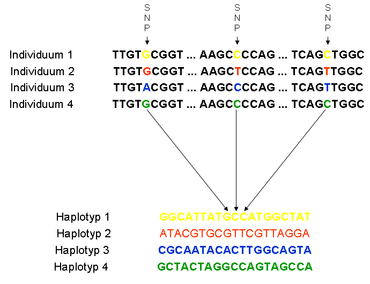Haplotype
![]()
The articles Haplotype and Haplogroup overlap thematically. Information that you are looking for here can therefore also be found in the other article.
You are welcome to participate in the relevant redundancy discussion or to help directly to merge the articles or to better distinguish them from each other (→ instructions).
A haplotype (from the ancient Greek ἁπλούς haplús, German 'simple' and τύπος týpos, German 'likeness', 'pattern'), an abbreviation of 'haploid genotype', is a variant of a nucleotide sequence on one and the same chromosome in the genome of a living being. A particular haplotype can be individual-, population- or even species-specific.
As in the International HapMap Project, the alleles compared can be individual combinations of SNPs that can be used as genetic markers. If some of the individuals have the same haplotype due to common ancestry at a certain gene locus, they are combined into a haplogroup.

Haplotypes from SNPs of chromosome segments of the same chromosome of four haploid individuals
History
The term was introduced by Ruggero Ceppellini in 1967. It was originally used to describe the genetic composition of the MHC, a complex of genes that encodes proteins important for the immune system.
Distinction from genotype
If a diploid organism has the genotype AaBb with respect to two genes A and B, this can be based on the haplotypes AB|ab or Ab|aB. In the former case, one chromosome possesses the alleles A and B, the other a and b. In the latter case, one chromosome possesses the alleles A and b, the other a and B.
Questions and Answers
Q: What is a haplotype?
A: A haplotype is a collection of specific alleles in a cluster of tightly-linked genes on a chromosome, usually inherited together.
Q: What is the short form of haploid genotype?
A: The short form of haploid genotype is haplotype.
Q: What is the use of haplotype in genetics?
A: Haplotype is used to investigate the genetics of common diseases by identifying all other sites in its region.
Q: How can the degree of genetic relationship be shown using haplotypes?
A: The degree of genetic relationship between two or more people can be shown by comparing their respective haplotypes.
Q: What is the second meaning of haplotype?
A: The second meaning of haplotype is a set of single-nucleotide polymorphisms (SNPs) usually found together on a single chromatid.
Q: How is haplotype used in genetic genealogy projects?
A: Haplotype is used in genetic genealogy projects to compare the haplotypes of two or more people and show the degree of genetic relationship between their respective lines.
Q: Why is identifying haplotypes important?
A: Identifying haplotypes is important for investigating the genetics of common diseases and can provide valuable information in genetic genealogy projects.
Search within the encyclopedia